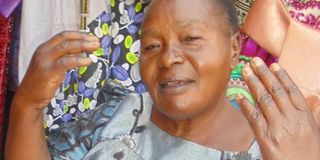Nakankya has been voting since 1980

Gladys Nakankya has voted in six general elections. Photo by fred muzaale
Gladys Nakankya, a resident of Kayunga Town, has been voting in the country’s general election since 1980.
Born in 1952, the businesswoman and politician was aged 28 years, when the 1980 general election was held.
She has since participated in the country’s subsequent election of 1996, 2001, 2006 and 2011.
“As an active youth, I participated in the campaigns and voting during the 1980 general elections,” Nakankya says, adding, “However, the whole election process was marred by massive intimidation, harassment and murder of mainly Democratic Party (DP) supporters,” she says.
There were four political parties that participated in the 1980 elections. These were; UPC headed by late Milton Obote, DP (Kawanga Ssemogerere), CP (Mayanja Nkangi) and UPM (Yoweri Museveni).
Election 1980
Nakankya says during the 1980 general election, registration of voters was done and supervised by UPC supporters. This, she says, gave a chance to UPC to include ghost names in the voter’s register.
“The UPC youth wingers made it extremely difficult for people who were perceived to be DP supporters to register. However, even some of those who managed to be registered had their names removed from the register,” Nakankya says.
Comparing the 1980 election with the subsequent elections, she says during the 1996, 2001, 2006 and 2011 general elections, registration of voters was done by voter registrars, who were recruited by the Electoral Commission in the respective districts.
“During these elections, voter registrars were recruited without giving consideration to their political affiliation. Because the registrars were not recruited by a political party that participated in the election, the registrars did not mess up with the registration exercise and allowed all voters to register,” Nakankya explains.
In the 1980 elections, she says, there was no sensitisation of voters on the election process as was the case during the 2001, 2006 and 2011 elections. For instance, she says, voters were not told how the voting exercise was to be done and where the polling stations were stationed.
She says they were not told what they were supposed to do and not to do.
Nakankya says the entire campaign period of the 1980 elections was marred by intimidation. She says in her area (Bugerere) a number of DP candidates were arrested only to be released after the elections. Some, she says were killed.
Fast forward
“Even during the 1996, 2001, 2006 and 2011 elections, there was intimidation of some Opposition supporters and candidates especially FDC and DP,” Nakankya says, adding, “Some of them were arrested while others were shot during the campaigns,”
She says the mood during the 1980 election process was tense as mainly DP supporters, the party enjoyed massive support across the country feared for their lives.
Prior to voting day, Nakankya says, there were indiscriminate arrests which were referred to as pandagaari carried out by UPC youth wingers.
“Out of fear of backlash, some people who were to act as polling agents for DP, CP or UPM did not turn up on the voting day,”
She says in the 1980 elections, they had to walk long distances to go and vote. This was because the polling stations were at parish level unlike the subsequent elections where polling stations are at village level.
The long distances deterred some people from voting.
The polling stations during the 1980 elections were concealed inside buildings.
“The opaque ballot boxes were placed inside a room, where nobody would see what was happening. This gave chance to UPC to give extra ballot papers to their supporters to cast,” she says.
The practice then
During that election, she says, each party had a separate ballot box which also had the party symbol. The ballot papers had no photos of candidates or their symbols.
She says the voters did not do anything on the ballot paper as they simply had to receive it and then cast it into a box of his/her party.
However, Nakankya says during the 2001, 2006, 2011 elections, it was different as all candidates’ photos were placed on one ballot paper.
So the voters had to tick a candidate of their choice before casting their vote in one ballot box.
She adds, “Voting during the 2001, 2006 and 2011 elections was transparent because the polling stations were located in the open, which made it difficult for one to ballot stuff.”
During the 1980 elections, counting of votes was not done immediately at the polling stations like it was with subsequent elections. This created a lot of suspicion especially among the electorate.
She says instead, the ballot boxes were carried to the constituency headquarters where the counting was done.
This, she says increased the possibility of the DP votes being rigged.
In addition, some of the DP ballot boxes were confiscated along the way. This Nakankya says was intended to give UPC an upper hand.
This year, Nakakya is excited that she is going to participate in her sixth election and she hopes it will be a good experience.




